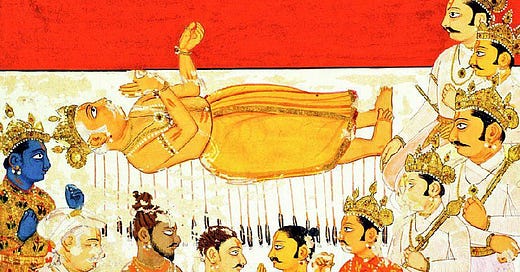The Hindu year is divided into two sections known as Uttarayanam which extends from January 14th to July 14th or 15th and Dakshinayanam which is from July 15th to January 14th when the sun is seen to be slowly moving towards the south. “Uttara” means north and “Dakshina” means south. “Ayanam” means “way”, so Uttarayanam is the northern path of the sun and Dakshinayanam is the southern path of the sun.
Uttarayanam is considered to be very auspicious for celebrating all noble events like marriages, house warming etc. It is said to be the “day of the gods” just as Dakshinayanam is said to be their night. Thus, Uttarayanam is also said to be the best time for the year to depart from this planet since the gods will be awake to welcome you! The great Mahabharata war took place in December during Dakshinayanam. Bhishma was the son of Ganga and the great-grandsire of both the Pandavas and the Kauravas. He was the great hero of the battle and supposed to be invincible. He was the most revered character in the Mahabharata.
However, he fell on the 10th day of battle. So many arrows had pierced through him that as he fell backwards, he was supported by the arrows which made a macabre bed for him. The battle stopped when he fell and both parties flocked around him to pay their last respects. He had been given the boon that he could choose the time of his departure from this planet and he chose not to die at this inauspicious time of Dakshinayanam. He told them to shift him to a safe place where he could stay till Uttarayanam began.
Even though Uttarayanam begins on the 14th January, the sun does not start its northward journey till “Ratha Saptami” which occurs on the 7th day of the bright phase of the lunar month. So, Bhishma waited on his bed of arrows till the 8th day of the lunar month and left his mortal frame. This day is known as Bhishma Ashtami and this is the day when the great hero left his body and rose to the celestial regions. Lord Krishna and the Pandavas were with him at this time. Lord Krishna stood at his feet and looked at him with love overflowing from his eyes. Bhishma was filled with ecstasy. He beheld that wondrous form in front of him and extolled him by chanting the famous “Vishnu Sahasranama” – the one thousand and one names of Lord Vishnu! Krishna gave him the final benediction and allowed him to leave his mortal frame.
This happened on the 8th day of the bright fortnight of the month of Magha - January/February and hence it is celebrated as Bhishmashtami. This is celebrated in most parts of Bharat. In the state of Bengal, special pujas and rituals are held during the day. The day is celebrated with great dedication and fervour in Vishnu temples all over the country.
Childless couples as well as newly married couples observe a strict fast on this day, in order to be blessed with a noble son like Bhishma. The fast is supposed to take away “putra dosha” or inability to have children.
Thus, our Itihasas (The Ramayana and the Mahabharata) have given us untold profiles of noble souls whose footsteps we should follow and many asuric characters whose characteristics we should avoid!
This year, 2025, Ratha Saptami is on Tuesday 4th February and Bhishmashtami is on Wednesday 5th February.
Hari Aum Tat Sat





Was significant to learn that the liberating Vishnusahasranamen mantra was voiced by sage Bhisma